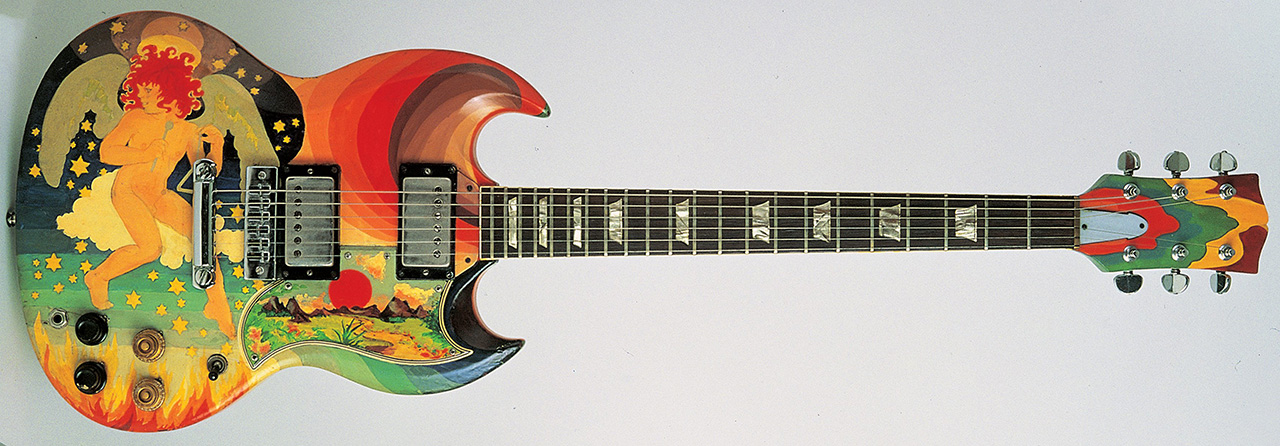“One of Eric Clapton’s guitars went for half a million dollars. I was, as I often am, in trouble with the IRS. I thought, ‘This is probably the time’”: Todd Rundgren’s love affair with Clapton’s Fool SG, and how he moved on after selling it
He rescued it from peeling-paint hell, restored it after the headstock snapped off, but was never fully happy with the psychedelic Gibson. Then a fan offered a happily-ever-after solution

The Fool SG is one of the most iconic guitars in rock, playing a starring role in Eric Clapton's Cream career.
It was the guitar with which his infamous ‘woman tone’ was cultivated, and can be heard on seminal tracks such as Sunshine of Your Love, White Room and I Feel Free.
Built in 1964, the Gibson received an eye-catching paint job courtesy of Dutch design collective The Fool, and became a totem of the psychedelic era and 1967's Summer of Love.
Following Cream's demise, Clapton passed the guitar on to his close friend George Harrison, who in turn gave it to guitarist and singer-songwriter Jackie Lomax.
And it was at that point that another rock legend, Todd Rundgren, stepped in to save it from a seedy death in Woodstock, NY, snapping it up for just $500.
The guitar would remain in his possession until 2023, when it was auctioned and sold for $1.27 million – making it one of the most expensive guitars ever sold at auction. Not a bad return on investment.
Do you remember the first time you saw The Fool?
All the latest guitar news, interviews, lessons, reviews, deals and more, direct to your inbox!
“It was the first time that Cream played in the US. They were doing the Murray the K Show at the Paramount Theater in Brooklyn. I hadn’t seen a lot of pictures of Eric, but everyone remembers the photo on the back of the Bluesbreakers record, where he’s sitting there with his Les Paul.
“I expected that, but he came out with this psychedelic SG, and I was like, ‘Wow, that’s weird!’ And he had his hair in an afro, which was equally weird! I saw The Fool up close a lot in the early days because Cream would play in these tiny underground clubs, and I was six feet away from his Marshall stack. So I knew Sunny pretty well before I ever met Sunny personally.”
Why did you call the guitar Sunny?
“Because of Sunshine of Your Love, and because it’s got a sunrise on it.”

What led to you owning the SG?
“I’m in Woodstock years later and somebody says, ‘Jackie Lomax has the original Fool guitar, and wants to sell it.’ I went over to visit him and there was The Fool – in the worst possible shape you could imagine.
“The paint job was flaking off. Eric had sweated through the paint job and into the wood; it was like balsa at that point. The bridge had been replaced with a wooden bridge, and the action was super-high because they were using it as a lap guitar.
“Jackie said, ‘If you give me the money I’ll loan it to you, then I’ll buy it back from you.’ He never showed up to buy it back – until like three decades later, when he thought he could give me $500 and get it back!
“That’s what it cost me: I gave Jackie Lomax $500. But it was really beat up; it wasn’t long after that that the headstock just snapped off the guitar altogether.”

How did you go about restoring it?
“The first thing I did was change it back to a standard bridge. I got rid of the wooden bridge and it didn’t have the original bridge anymore, and I played it as-is for a while.
“There were very few pictures of the back and the back of the neck, so we had to fake a joint for a new headstock. I played it for a very long time after that, but it was rarely my main instrument because it was kind of fragile. I got nervous about taking it out on the road – something might happen to it or it might get stolen. So I kept it off the road for a long time.”
What was the guitar like to play?
“You could get up there on the neck without any wood getting in the way. I liked to do that – go up to that double-high E, and choke it, baby!
”But pickup winding became an issue. The range of what you could get was hampered a bit. And it was a Gibson, so it had that characteristic Gibson humbucker sound. So if you wanted a different sound, you had to play a different guitar.”
A Japanese guy showed up at a show with a dead-on replica, except he’d never seen the original one
Why did you auction it?
“In the ’90s, Eric auctioned off a bunch of his guitars, and one that he’d played a lot, called Brownie, went for about half a million dollars. I was – as I often am – in trouble with the IRS, so I thought, ‘This is probably the time.’ I had Sotheby’s auction the guitar off and all the money went to the IRS. By then I had a replica.”
What’s the story behind that replica, given to you by a fan in the ’80s?
“A Japanese guy showed up at a show with it. It was a dead-on replica, except he’d never seen the original one. He’d painted it from pictures in a magazine, and the colors in the magazine were much brighter than the ones on the guitar.

“So, Sunny II – I guess – was a brighter-looking guitar. But it also had a different sound because, on the original Sunny, they’d unwound the pickups a bit to give it a sharper sound. So the replica with original pickups sounded a bit better than Sunny did!”
Does the replica play the same as the original?
“They were very similar to play. They were equally top-heavy; if you put your hands up the headstock would fall down, depending on how you had your strap! It was not balanced like a normal guitar, so you had to get used to that.
“Once you did, the luxurious part was the length of the neck, and that there was no obstruction all the way up to the top of the neck. You could get close without a whole lot of effort.”
- Todd Rundgren is on tour now.
Andrew Daly is an iced-coffee-addicted, oddball Telecaster-playing, alfredo pasta-loving journalist from Long Island, NY, who, in addition to being a contributing writer for Guitar World, scribes for Bass Player, Guitar Player, Guitarist, and MusicRadar. Andrew has interviewed favorites like Ace Frehley, Johnny Marr, Vito Bratta, Bruce Kulick, Joe Perry, Brad Whitford, Tom Morello, Rich Robinson, and Paul Stanley, while his all-time favorite (rhythm player), Keith Richards, continues to elude him.
You must confirm your public display name before commenting
Please logout and then login again, you will then be prompted to enter your display name.

